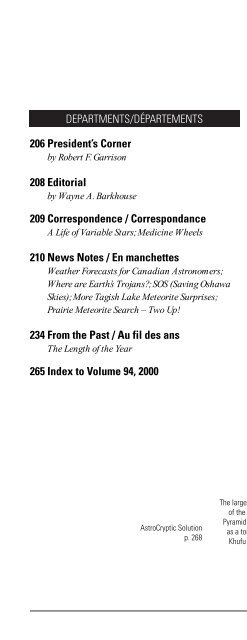I N S I D E T H I S I S S U E
insidethisissue - The Royal Astronomical Society of Canada
insidethisissue - The Royal Astronomical Society of Canada
- No tags were found...
You also want an ePaper? Increase the reach of your titles
YUMPU automatically turns print PDFs into web optimized ePapers that Google loves.
President’s Cornerby Robert F. Garrison (garrison@astro.utoronto.ca)After 13 years of searching, the pulsar powering Shelton’sSupernova finally has been found (Middleditch et al.2000, New Astronomy, 5, 243). The elusive pulsar remnantof Supernova Shelton 1987A is rotating with a period of 2.14milliseconds, which is not the fastest known. Can you imaginea compact object so dense that only neutrons can exist in it? Ifyou can imagine that, stretch your mind to picture an objectmore massive than the Sun squeezed into a sphere of diameterabout 30 km (give or take a few), rotating almost 500 timesevery second. These are interesting times for being involved inastronomy.Canadian Ian Shelton, the supernova’s discoverer, wasResident Observer at the University of Toronto SouthernObservatory (UTSO) on Cerro Las Campanas in the desertmountains of Chile. In the last semester of his four-year stint(1981-1983, 1985-1987), he spotted the supernova, which wasthe brightest since 1604, five years before the first use of atelescope. His claim to credit for the discovery is supported byphotographic evidence: before and after plates of the LargeMagellanic Cloud taken twenty-four hours apart. He used anancient ten-inch, wide-angle telescope stopped down to fiveinches to improve the images for that first exciting night. Thediscovery images were followed by the first photoelectricphotometry of the rapidly brightening supernova, using theUTSO 60-cm telescope. The next night, observers far enoughsouth to see it at –69 degrees were looking at it and takingwhatever data they could. Ian observed it every clear night fromFebruary 23 until July 1, sometimes changing instruments severaltimes per night. A very large telescope would not have had therequired observing time available, and instrument changes areoften difficult and time consuming on the largest facilities.At the UTSO, the late Jerry Kristian of the CarnegieObservatories installed a specially designed, high-speed photometer(referred to as The Black Box) for detecting the remnant, probablya pulsar, which was expected to have a period of order 1 millisecond(ms). Ian checked for it once every clear night for as long as thesupernova was visible with the UTSO telescope, which turnedout to be about a year and a half. After that The Black Box wastransferred to the 4-meter telescope at the Cerro TololoInterAmerican Observatory and used occasionally, but not everyclear night. A 0.5-ms periodicity was later detected but discountedas an artifact of the equipment used.My point here is to emphasize that not all discoveries aremade with huge telescopes by professional astronomers. In1987, Ian Shelton had only a B.Sc., though now he has a Ph.D.and is working at the giant 8.4-m Subaru Telescope. Also, it canbe argued that many other important discoveries are madeusing telescopes within the range of amateur astronomers. ForThe Journal is a bi-monthly publication of the Royal Astronomical Society of Canada and isdevoted to the advancement of astronomy and allied sciences. It contains articles on Canadianastronomers and current activities of the RASC and its centres, research and review papersby professional and amateur astronomers, and articles of a historical, biographical, oreducational nature of general interest to the astronomical community. All contributions arewelcome, but the editors reserve the right to edit material prior to publication. Researchpapers are reviewed prior to publication, and professional astronomers with institutionalaffiliations are asked to pay publication charges of $100 per page. Such charges are waivedfor RASC members who do not have access to professional funds as well as for solicitedarticles. Manuscripts and other submitted material may be in English or French, and shouldbe sent to the Editor-in-Chief.Editor-in-ChiefWayne A. BarkhouseDepartment of AstronomyUniversity of Toronto60 St. George StreetToronto, OntarioM5S 3H8, CanadaInternet: barkhous@astro.utoronto.caTelephone: (416) 978-2528Fax: (416) 946-7287Associate Editor, ResearchDr. Douglas HubeInternet: dhube@phys.ualberta.caAssociate Editor, GeneralMichael AttasInternet: michael.attas@nrc.caAssistant EditorsMichael AllenMartin BeechRalph ChouPatrick KellyDaniel HudinEditorial AssistantSuzanne E. MoreauInternet: semore@sympatico.caProduction ManagerDavid LaneInternet: dlane@ap.stmarys.caThe Journal of The Royal Astronomical Society of Canada is published at an annual subscriptionrate of $80.00 by The Royal Astronomical Society of Canada. Membership, which includesthe publications (for personal use), is open to anyone interested in astronomy. Annual feesfor 2000, $40.00; life membership is $800. Applications for subscriptions to the Journal ormembership in the RASC, and information on how to acquire back issues of the Journal canbe obtained from:The Royal Astronomical Society of Canada136 Dupont StreetToronto, Ontario, M5R 1V2, CanadaInternet: rasc@rasc.caWebsite: www.rasc.caTelephone: (416) 924-7973Fax: (416) 924-2911Contributing EditorsMartin Beech (News Notes)David ChapmanKim Hay (Society News)Bruce McCurdyHarry PulleyLeslie SageRuss SampsonDavid Turner (Reviews)Mary Lou Whitehorne (Education Notes)ProofreadersSteven BurnsJames EdgarMaureen OkunSuzanne MoreauDesign/ProductionBrian G. Segal, Redgull IncorporatedAdvertisingIssac McGillisTelephone: (416) 924-7973PrintingMacNab Printers Ltd.Canadian Publications Mail Registration No. 09818Canada Post: Send address changes to 136 Dupont St., Toronto, ON M5R 1V2We acknowledge the financial support of the Government of Canada, through the PublicationsAssistance Program (PAP), toward our mailing costs.U.S. POSTMASTER: Send address changes to IMS of NY, P.O. Box 1518, Champlain, NY 12919.U.S. Periodicals Registration Number 010-751.Periodicals postage paid at Champlain, NY and additional mailing offices.© 2000 The Royal Astronomical Society of Canada. All rights reserved. ISSN 0035-872X206JRASC December / décembre 2000
















